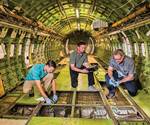A better method of structural health monitoring?
Fibersail, a 2014 startup firm with offices in Rotterdam, The Netherlands and Leça de Palmeira, Portugal, aims to change the current state of real-time structural health/shape monitoring for composite structures — initially, for wind farm operators.
Fibersail, a 2014 startup firm with offices in Rotterdam, The Netherlands and Leça de Palmeira, Portugal, aims to change the current state of real-time structural health/shape monitoring for composite structures — initially, for wind farm operators. The company says it has developed a system to monitor and analyze the behavior of wind turbine blades in terms of shape, in real time. The user-friendly system provides information to help operators prevent blade failures and reduce overall wind farm maintenance costs.
CEO and company co-founder Pedro Pinto spoke with me recently to describe the Fibersail system and the benefits available to users. Several fiber optic cables, fitted with multiple Fiber Bragg Grating (FBG) sensors, are applied to a flat composite batten. The sensors are “related” to each other by the company’s proprietary algorithms and software, which allow monitoring of both flapwise and edgewise movements for documentation of three-dimensional structural deformation. The batten or measurement tool is not intended to be embedded within a composite laminate, but rather to be adhered on the interior or exterior surface of the structure to be measured (e.g., wind turbine blade), preferably in a pre-fabricated slot, but in theory anywhere appropriate for that structure, says Pinto: “Imagine a ruler that you use to measure. We consider our sensor like a digital ruler, which the client can simply attach and start measuring. It could be placed inside the wind blade for monitoring in the real environment, or on the outer surface in testing facilities.”
Fibersail doesn’t require specialist operators for application purposes, but rather allows engineers access to a machine learning-based user interface in a tablet-readable system, says Pinto: “We of course know of other companies with shape sensing systems, but we are working on a different perspective. We ship a ready-to-use system that requires no special interpretation.” He points out that if an embedded FBG system (within a laminate) has a problem or stops working, the structure can no longer be monitored with disassembly access, such as the inside of a blade tip.
The company’s goal is a simpler, efficient method of critical structures monitoring, one that eliminates costly and time-consuming manual visual inspections by climbers. Reducing these inspections can significantly reduce wind farm costs. Plus, the real-time monitoring can alert operators to impending catastrophic blade failures, and allow targeted maintenance only where needed. Pinto says a test will be undertaken this spring in Europe in collaboration with a well-known blade producer to verify the Fibersail system in an installed wind farm. “We offer a technology that can reduce costs compared to older monitoring strategies, and yet give precise and accurate information for operators. We are shaping the structures of tomorrow,” concludes Pinto. Visit the company’s Web site for more information or to contact the group: http://www.fibersail.com/. Click this link for a recent CW story on structural health monitoring in aerospace: www.compositesworld.com/articles/structural-health-monitoring-ndt-integrated-aerostructures-enter-service .
Related Content
-
Automated robotic NDT enhances capabilities for composites
Kineco Kaman Composites India uses a bespoke Fill Accubot ultrasonic testing system to boost inspection efficiency and productivity.
-
Plant tour: BeSpline/Addcomp, Sherbrooke, QC, Canada
Composites automation specialist increases access to next-gen technologies, including novel AFP systems and unique 3D parts using adaptive molds.
-
Jeep all-composite roof receivers achieve steel performance at low mass
Ultrashort carbon fiber/PPA replaces steel on rooftop brackets to hold Jeep soft tops, hardtops.













.jpg;maxWidth=300;quality=90)

